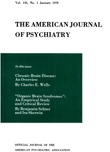FAILURES IN PSYCHIATRY: THE CHRONIC HOSPITAL PATIENT
Abstract
1. The records of 2,166 patients who had been hospitalized continuously for two years or more were studied to identify the nature of the mental disease itself and to tabulate certain sociological resources which might play a part in the patient's failure to recover and return to the community.
2. Schizophrenics comprise 63% of the males and 67% of the females. Organic psychoses account for 20% of the males and 18% of the females, while functional psychoses other than schizophrenia make up the remaining 17% of the males and 15% of the females.
3. Median age of the males is 53 years and of the females 57 years.
4. At the time of admission only 22% of the males and 34% of the females were married. This proportion is now smaller, since some patients have been divorced or widowed since admission.
5. At the time of admission only 23% of the males and 27% of the females had both parents living ; many of these parents have since died.
6. Most of the chronic patients had a poor educational background. Eight grades of school or less represented the educational achievement of 74% of the males and 63% of the females. Only 13% of the males and 22% of the females had completed high school or more.
7. Occupational level is essentially that of unskilled labor—68% of the males and 70% of the females having no occupation or being unskilled laborers. Professional workers were almost nonexistent among the chronic males.
8. Whatever the number of living relatives, most of the chronic patients seem to have few interested relatives. Over the last two years the hospital received more than three letters of inquiry in only 9% of the male cases and in only 15% of the female cases. Only 8% of the total have more than 20 dollars while 69% have no personal spending money at all.
9. The data are compared with similar information obtained on 400 discharged patients.
10. Distinction is made between those patients who have become chronic and are described in this paper and the patients currently entering the hospital who are candidates for chronicity. Awareness of the social factors described may facilitate the manage- ment of these cases and help prevent chronicity.
Access content
To read the fulltext, please use one of the options below to sign in or purchase access.- Personal login
- Institutional Login
- Sign in via OpenAthens
- Register for access
-
Please login/register if you wish to pair your device and check access availability.
Not a subscriber?
PsychiatryOnline subscription options offer access to the DSM-5 library, books, journals, CME, and patient resources. This all-in-one virtual library provides psychiatrists and mental health professionals with key resources for diagnosis, treatment, research, and professional development.
Need more help? PsychiatryOnline Customer Service may be reached by emailing [email protected] or by calling 800-368-5777 (in the U.S.) or 703-907-7322 (outside the U.S.).



